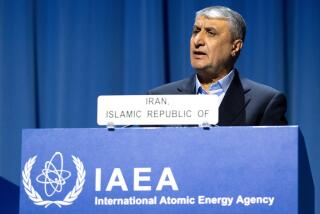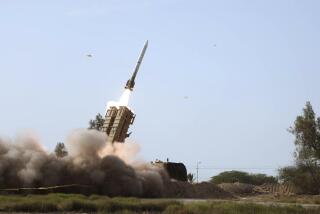Iranâs Nuclear Steps Quicken, Diplomats Say
VIENNA â With efforts to halt its nuclear program at an impasse, Iran is moving faster than expected and is just days from making the first steps toward enriching uranium, said diplomats who have been briefed on the program.
If engineers encounter no major technical problems, Iran could manufacture enough highly enriched uranium to build a bomb within three years, much more quickly than the common estimate of five to 10 years, the diplomats said.
Iran insists that it is interested only in producing electricity, which requires low-grade enrichment of uranium.
New information about Iranâs program came from diplomats representing countries on the United Nations Security Council. They were briefed by senior staff of the International Atomic Energy Agency, which maintains monitors in Iran. The diplomats spoke on condition of anonymity because the briefing was private.
Even as Iran apparently moves forward, diplomatic efforts to persuade it to halt its nuclear work appeared to be faltering in the face of distrust among powerful Security Council members and disagreements over the best strategy.
âWeâre getting conflicting signals from the United States; it now appears they want to escalate the situation,â said a senior diplomat in Vienna. âThe Russians see that as a slippery slope.â
Officials said Iran was on the verge of feeding uranium gas into centrifuges, the first step toward enrichment. That move is in keeping with Iranâs experience level and its previous statements, experts said.
According to one non-Western official who closely follows Iranâs progress, engineers at a pilot plant in Natanz are likely to start crucial testing in the next couple of days to ensure that the centrifuges and the pipes connecting them are properly vacuum sealed. They are likely to begin feeding uranium hexafluoride gas into a series of 164 connected centrifuges within about two weeks, the official said.
Diplomats and experts say Iran has forgone usual testing periods for individual centrifuges and small series of linked centrifuges, instead apparently trying to put together as many as possible, as quickly as possible.
They said Iran also was likely to begin assembling more centrifuges in mid-April to put together additional cascades of linked centrifuges. The pilot plant can hold up to six cascades of 164 centrifuges each. It could take many months to complete that work, the diplomats said.
The U.S. and its British, French and German allies believe Iran intends to build nuclear weapons, and must be stopped before learning how to enrich uranium. They view the ability to operate a series of centrifuges as a technological tipping point.
âIf you can do one centrifuge, you can do 164,â said Emyr Jones Parry, British envoy to the U.N. âIf you can do 164, you probably can do many more. That means you have the potential to do full-scale enrichment. If you can do enrichment up to 7%, you can do 80%. If you can do 80%, you can produce a bomb.â
Policymakers watching Iranâs program are making two separate assessments: a technical one based on Iranâs ability to enrich uranium and a political judgment on whether Iran is attempting to make a bomb or merely trying to enrich uranium to a low level for civilian purposes, as Iranian officials insist.
The three-year time frame for Iran to produce a bomb cited by diplomats is the same as an estimate by former nuclear weapons inspector David Albright.
In a paper that will be released Monday by the Institute for Science and International Security, which Albright founded, he and a colleague give a detailed description of how, under a best-case scenario, Iran would be able to manufacture enough highly enriched uranium for a crude nuclear device in three years. Albright cautioned, however, that Iran faces many technical hurdles it might find difficult to overcome.
Gary S. Samore, a former nonproliferation expert at the National Security Council, now at the John D. and Catherine T. MacArthur Foundation, also said it was far more likely that the Iranians would encounter problems and that it could take them four to five years.
If Iran decides to make highly enriched uranium, it would need either to do so clandestinely, or leave the Nuclear Nonproliferation Treaty, which prohibits signatories from producing highly enriched uranium.
The IAEA board of governors reported Iran to the Security Council for failing to respond to requests from inspectors for information about its program, which it kept hidden for 18 years.
All the members of the Security Council agree that Iran should not be permitted to produce a bomb. Under an agreement with Russia and China, the council only began to discuss Tehranâs case in mid-March. The next steps are hotly disputed.
The European Union and the Americans want to exert vigorous pressure on Iran. They insist on a reinstatement of a total moratorium on uranium enrichment that Iran had voluntarily put in place in late 2004 while negotiating with the EU. The U.S. and EU are willing to use a U.N. procedure that gives Security Council resolutions the force of law, and to impose sanctions.
The Russians and the Chinese, mindful of the buildup to the U.S.-led invasion of Iraq three years ago, fear that taking too hard a line would lead to an escalation of tensions that could result in military action against Iran. They believe that sanctions and other measures might push Iran to abandon the nonproliferation treaty, which keeps international inspectors in the country.
Russia and China would be willing to allow Iran to retain a small cascade of centrifuges for research purposes.
The difference among the permanent Security Council members suggest it could be a long time before they reach a consensus.
âI donât think anyone can predict if there will be serious action in the Security Council,â said Stephen G. Rademaker, acting assistant secretary of State for security and nonproliferation, in an interview this week.
The U.S. and its allies face the difficulty of allaying Russian suspicion that reporting Iran to the Security Council was a way to make the case for military action.
âThe Russian concern is with the medium- and long-term plan: âWhereâs it going?â â said a diplomat from a European Union country. âEven though we say military action is not an option, they have a concern that weâre going down a route that ends up in a single place.â
The diplomat said the Westâs counter-argument is that moving ahead in a unified way sends a signal that the five powerful permanent members of the Security Council are united and that Iran needs to listen.
However, getting Russia on board probably will be more difficult after a letter written by John Sawers of the British Foreign Office to his counterparts in the United States, France and German, was leaked this week. The letter touched on several issues, including the need for the U.S. to be involved in a package of incentives for Iran to halt its uranium enrichment, but it also made it clear that the U.S. and its European partners jointly were negotiating a position without consulting the Russians and Chinese.
âMoscow is unlikely to agree to anything devised behind its back and then presented as the sole solution possible,â said Russian Foreign Minister Sergei V. Lavrov.
In the meantime, the situation is changing daily as the Iranians move ahead.
âWeâre getting to the point where this fundamental difference between the U.S. and EU position and that of the Russians is being overtaken by Iranâs ... putting new facts on the ground,â said Mark Fitzpatrick, a nuclear nonproliferation expert at the International Institute for Strategic Studies in London, who previously worked for the U.S. State Department on nuclear issues. âIran is closer and closer to enrichment, so the effort to deny them the capability is rapidly failing.â
*
Rubin reported from Vienna and Farley from the United Nations.
More to Read
Sign up for Essential California
The most important California stories and recommendations in your inbox every morning.
You may occasionally receive promotional content from the Los Angeles Times.










